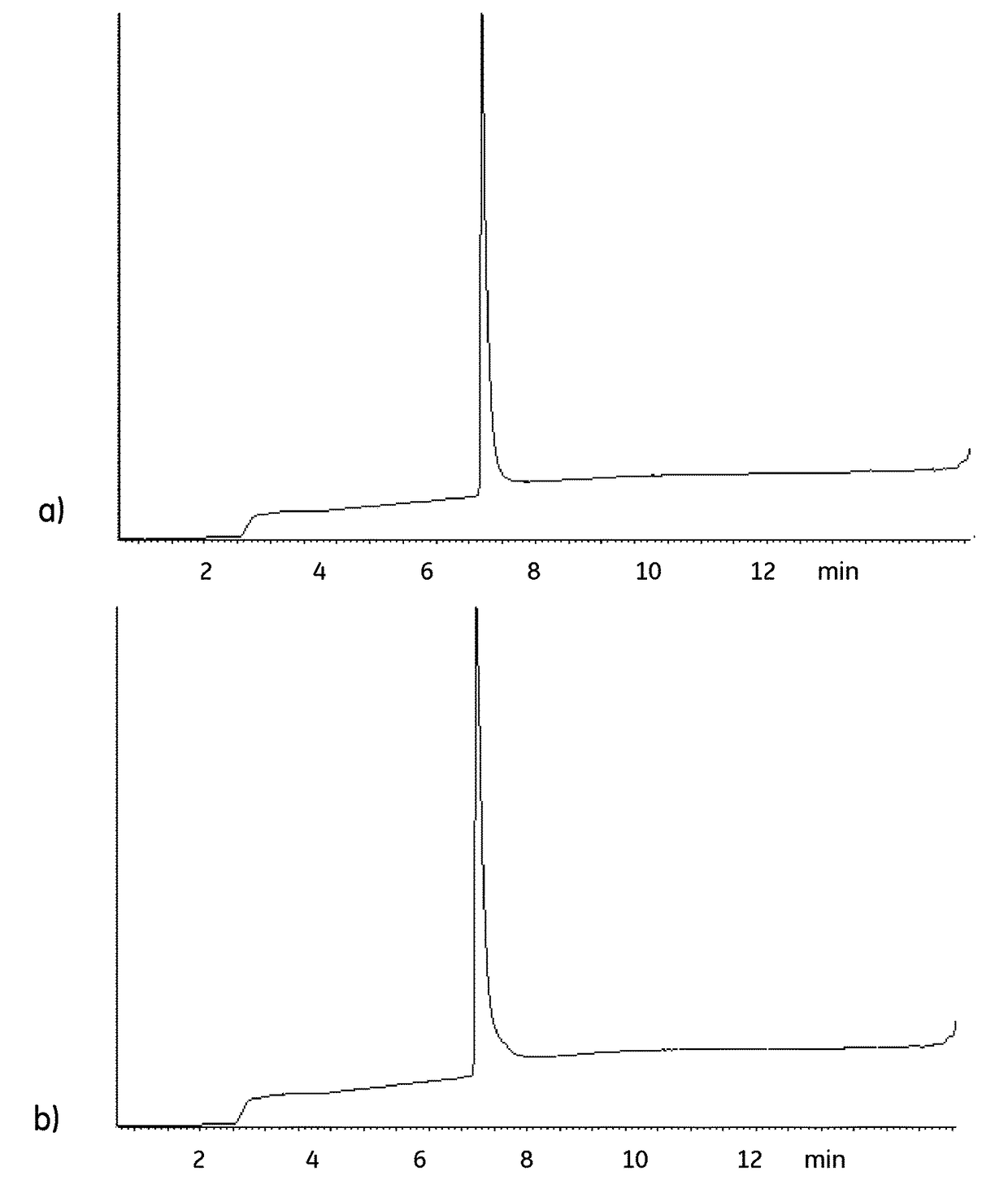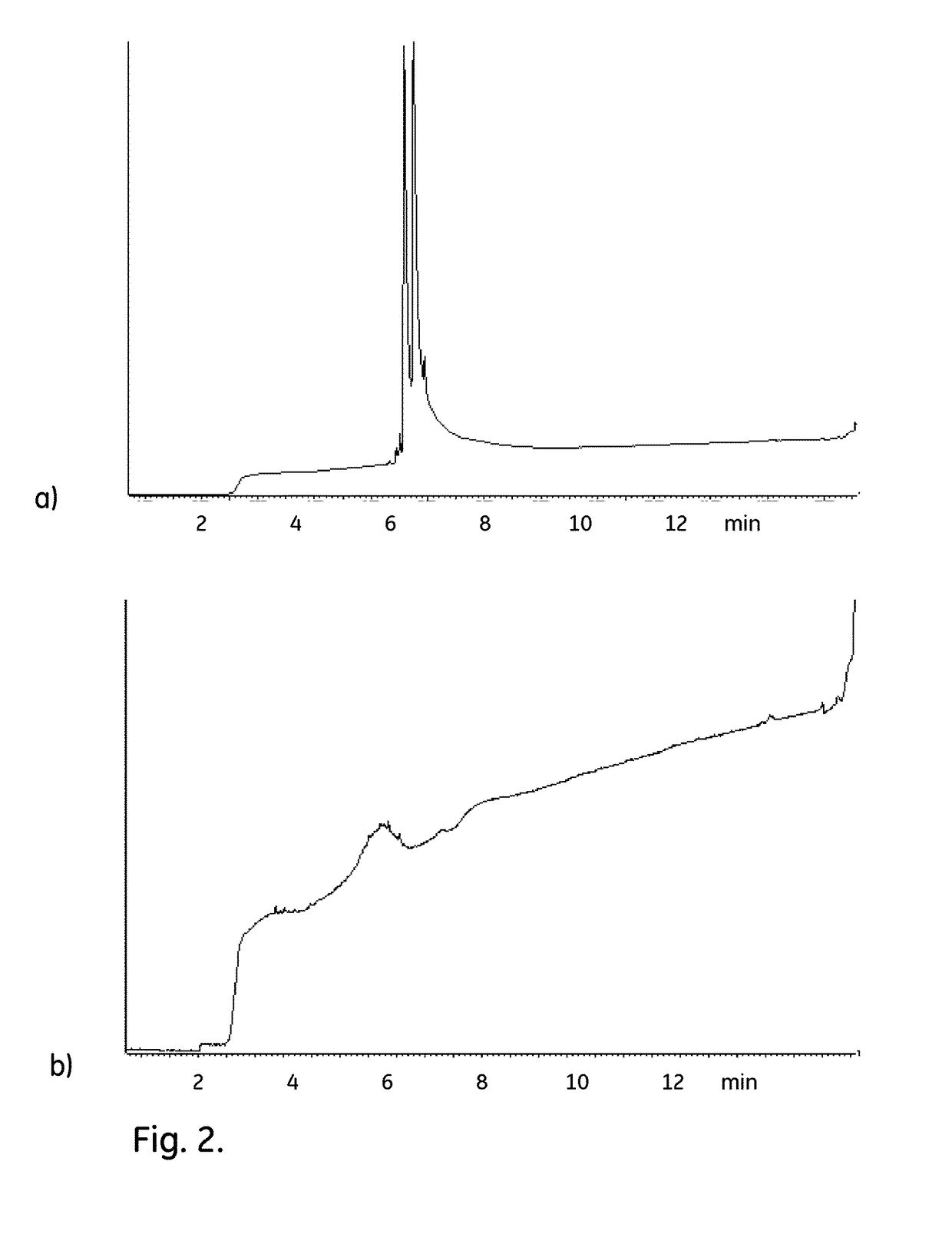Sanitization Method for Affinity Chromatography Matrices
a technology of affinity chromatography and sanitization method, which is applied in the field of affinity chromatography, can solve the problems of difficult to find conditions that effectively kill microorganisms and spores without damaging the ligands, and achieve the effect of high degree of bacteria and spore inactivation
- Summary
- Abstract
- Description
- Claims
- Application Information
AI Technical Summary
Benefits of technology
Problems solved by technology
Method used
Image
Examples
example 1 (
Capto L Sanitization Study)
[0052]The purpose of this investigation was to evaluate the bactericidal and sporicidal effect on bacterial spores and bacteria of eight disinfectants as well as PBS as reference added to Capto L 50% slurry. The effect was tested with contact times of 0 and 15 minutes as well as 1, 4, and 24 hours.
[0053]The test was performed in slurries of Capto L 50% and disinfectants. Microorganisms were added at a concentration of approximately 107 cfu / mL to the suspension and the reducing effect was evaluated after given time intervals by neutralizing the disinfectant. The efficacy of the neutralizer and its ability to recover the inoculated microorganisms was demonstrated by validating the method in parallel with the challenge test. The results were evaluated with regard to log 10 reductions of the microorganisms Bacillus subtilis (spores) and Pseudomonas aeruginosa (vegetative bacteria).
[0054]107 cfu / mL of the microorganism was added to 10 mL of Capto L 50% slurry w...
example 2 (
Ligand Incubation, Biacore Test)
[0055]The aim with this activity was to study the binding kinetics of different chromatography media ligands as a measure of the retained binding capability before and after sanitization with 0.1 M Peracetic acid (PAA). The kinetics was measured by Surface Plasmon Resonance on a Biacore™instrument. The ligands tested were monomers (Z1) and tetramers (Z4) of SEQ ID NO: 13, recombinant Protein A (rPrA), recombinant Protein L (rPrL) and single-chain camelid antibodies against IgG kappa chains (KappaSelect ligand). Z1, Z4 and rPrA were tested with a monoclonal antibody immobilized on a Biacore chip, while rPrL and the KappaSelect ligand were tested with an immobilized Fab antibody fragment.[0056]1. 1 ml 10 mg / ml Z1, Z4 and rPrA were reduced, alkylated and buffer exchanged to 10 mM NaCl and analyzed on a mass spectrometer (MS) to verify the reduction and alkylation.[0057]2. 1 ml rPrL and KappaSelect ligand were diluted to 10 mg / ml.[0058]3. Reference sample...
example 3 (
Matrix Incubation)
[0066]The aim with these experiments was to test the Sanitization in place (SIP) compatibility of different affinity chromatography media. This was done by calculating the 10% breakthrough dynamic binding capacity (DBC) after SIP with 0.1 M Peracetic acid on six different chromatography media packed in PreDictor RoboColumn 600 μl by using a TECAN robot. The initial DBC was measured on six corresponding reference columns which had not been subjected to SIP. The media were: Capto L (recombinant Protein L), KappaSelect (single-chain camelid antibodies against IgG kappa chains), MabSelect (recombinant Protein A), MabSelect SuRe (multimer of Protein Z variant with substituted asparagines), MabSelect SuRe LX (multimer of Protein Z variant with substituted asparagines) and MabSelect Xtra (recombinant Protein A). The support in all these media is rigid crosslinked agarose.
[0067]Methods[0068]1. Wash / removal of storage solution: 10 column volumes (CV) (6×1000 μl) 20 mM phosp...
PUM
| Property | Measurement | Unit |
|---|---|---|
| equilibrium dissociation constant | aaaaa | aaaaa |
| equilibrium dissociation constant | aaaaa | aaaaa |
| equilibrium dissociation constant | aaaaa | aaaaa |
Abstract
Description
Claims
Application Information
 Login to View More
Login to View More - R&D
- Intellectual Property
- Life Sciences
- Materials
- Tech Scout
- Unparalleled Data Quality
- Higher Quality Content
- 60% Fewer Hallucinations
Browse by: Latest US Patents, China's latest patents, Technical Efficacy Thesaurus, Application Domain, Technology Topic, Popular Technical Reports.
© 2025 PatSnap. All rights reserved.Legal|Privacy policy|Modern Slavery Act Transparency Statement|Sitemap|About US| Contact US: help@patsnap.com



